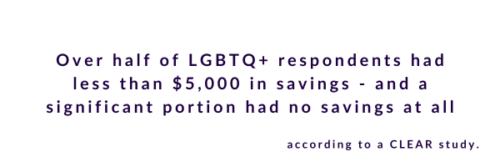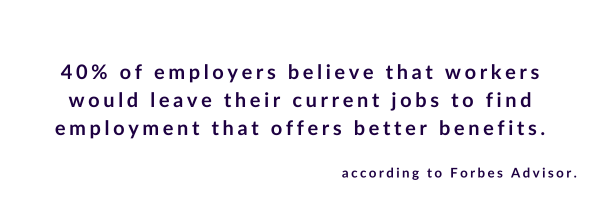
LGBTQ+ Employees and Money: 4 Unique Challenges to Wellbeing
LGBTQ+ Employees and Money: 4 unique challenges to wellbeing. LGBTQ employees have unique struggles that can affect their ability to build wealth. Here are the most important challenges to be aware of.
LGBTQ+ employees face unique financial challenges that affect their ability to earn money, build savings and achieve long-term financial stability.
According to a survey of 2,5000 LGBTQ+ individuals conducted by the Center for LGBTQ Economic Advancement & Research (CLEAR), over half of LGBTQ+ respondents had less than $5,000 in savings – and a significant portion had no savings at all. This figure is staggering compared to the average median savings reported by non-LGBTQ+ individuals: $25,700.
What’s more, LGBTQ+ employees are more likely to report discrimination in industries like banking and healthcare. Special healthcare needs such as family planning procedures and gender-affirming care may cost thousands of dollars – and are often paid out of pocket. Compounded with lower savings, this can make necessary care inaccessible to many Americans.
To support your LGBTQ+ employees, it’s essential not to overlook these unique challenges. Here are some of the financial roadblocks facing these workers, along with proven strategies to help mitigate their effects.
1. LGBTQ+ employees face higher levels of debt.
Debt is a significant issue for many Americans. A Northwestern Mutual study found that two-thirds of all respondents carried at least some debt.
However, LGBTQ+ individuals are disproportionately affected by their debt loads due to lower wages (90 cents to the dollar compared to the average worker), leading to higher levels of financial stress and instability.
Overall, LGBTQ individuals have more credit card and student debt, yet are less likely to carry valuable assets from their debt, such as mortgages or auto loans. This heightened debt burden can impede their ability to save for the future, invest in property or build wealth. The inability to pay off debt may also lead to mental health concerns including sleep problems, stress and anxiety.
The key to getting rid of bad debt is to use proven strategies that can be applied to different financial situations. Employers can use financial wellness programs to provide education on debt management and planning. These programs can access financial tools that help employees create and stick to a budget, manage debt, and create long-term goals.
2. LGBTQ+ employees have limited access to financial education.
A significant percentage of the LGBTQ+ community has less access to financial education, which affects their confidence in making financial decisions. According to Mercer, more than 30% of LGBTQ+ women and 25% of LGBTQ+ have difficulty addressing their financial options.
Only 49% of LGBTQ+ individuals feel they understand their financial options very well, compared to 61% of non-LGBTQ+ Americans. Financial illiteracy often leads to common pitfalls such as a lack of retirement savings and an inability to accumulate wealth over time.
Providing access to financial education that addresses the needs of the LGBTQ+ community is critical to closing the gap. Facilitating resources that tackle retirement planning, investment strategies and debt management is one of the best ways to set your employees up for success.
3. LGBTQ+ employees struggle with reduced access to elder care and retirement benefits.
LGBTQ+ seniors face significant challenges in accessing elder care and retirement benefits. Nearly two-thirds of LGBTQ+ Americans live paycheck to paycheck and struggle with building personal savings. Additionally, LGBTQ+ seniors often have fewer options for informal aging care, as they are more likely to be single or childless.
In fact, until changes in legislation over the past few years, LGBTQ+ seniors even lacked basic retirement rights including the ability to transfer Social Security, pension benefits and retirement plans to their surviving partners.
In order to support their employees, companies can offer retirement planning resources and benefits tailored to their specific needs. This includes providing access to financial wellness resources that discuss the unique challenges faced by LGBTQ+ seniors and offering comprehensive retirement plans that consider their circumstances and provide for their loved ones.
3. LGBTQ+ individuals face higher, more prohibitive healthcare costs.
LGBTQ+ employees also face higher healthcare costs and barriers to accessing appropriate care. Health plans may lack support for LGBTQ+ needs, such as gender-affirming care and non-traditional family planning. In fact, a 2022 CAP study, the most recent data available, found that LGBTQ+ adults are more than twice as likely as non-LGBTQ+ adults to postpone or forgo needed medical care because of costs.
Employers should ensure that their healthcare plans are inclusive and provide coverage for LGBTQ+ employees. This includes offering benefits that cover mental health services, nondiscriminatory care, and other specific healthcare needs. Providing access to this kind of support boosts wellbeing and makes potentially life-saving care more accessible.
Addressing the financial struggles of LGBTQ+ employees requires a holistic approach that focuses on financial wellness. Creating an inclusive workplace culture and offering targeted support requires hard conversations and input from your LGBTQ+ employees.
Use Best Money Moves to support your LGBTQ+ employees.
Best Money Moves is a mobile-first financial wellness solution designed to help dial down employees’ most top-of-mind financial stresses. As an easy-to-use financial well-being solution, Best Money Moves offers comprehensive support toward any money-related goal. With 1:1 money coaching, budgeting tools and other resources, our AI platform is designed to help improve employee financial well-being.
Whether it be retirement planning or securing a mortgage, Best Money Moves can guide employees through the most difficult financial times and topics. We have robust benefits options for employers, regardless of their benefits budget.
Our dedicated resources, partner offerings and 1000+ article library make Best Money Moves a leading benefit in bettering employee financial wellness.
To learn more about Best Money Moves Financial Wellness Platform, let’s schedule a call. Contact us and we’ll reach out to you soon.







